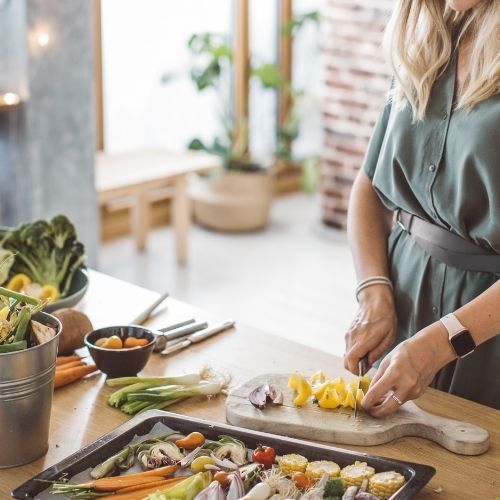Your Cart is Empty
COLLECTIONS:
SPECIAL OFFERS:
LEARN:

Benefits Of Low Impact Exercise
April 17, 2022 4 min read
by Samantha Thoms, MPH, RD
Are you guilty of believing the common myth about exercise, “No pain no gain”?
For many of us, the word “exercise” brings to mind images of struggling through a punishing workout and then collapsing in exhaustion as we tell ourselves “well done.”
Well, the time has come to put this myth to bed.
In reality, exercise does not have to be painful or very intense for us to reap major benefits. For those of us who want to avoid high impact exercise (think jumping or running), low impact exercise works just as well.
Low impact exercise has the power to protect joints, boost moods, improve physical fitness, and keep our bodies and minds healthy for longer.
Ready to learn how?
What Is Low Impact Exercise?
Low impact exercise describes any joint-friendly movements where one foot always stays on the ground.
In addition to reducing the risk of injury (as compared to high-impact activities), it may be a safer option for those of us who are pregnant, recovering from joint or spinal injuries, or just getting started with working out.

Best Low Impact Exercises
For best results, pick an activity that you enjoy. Gradually work up to doing30 minutes or more of physical activity most days.
You can break up those 30 minutes into several 10-minute chunks throughout the day.
It still counts.
If you want to get your heart rate up without putting more stress on your bones or joints, increase the frequency, intensity, or amount of time you spend doing low impact activities.
To keep things interesting, incorporate several different types of activities and invite others to join you.
1. Walking
Walking is the simplest form of low impact exercise. All you need is a good pair of shoes and a place to walk.
Add more walking into your day by parking a 5 minute walk away from your destination.
Boom!
You added 10 minutes of activity each time you walk to and from your car.
Make walking more fun by getting together with some coworkers on your lunch break.
Consider getting (or borrowing) a dog to keep you company.
Did you know dog owners aremuch more likely to meet recommended daily physical activity levels? Hint hint.
2. Biking
Biking can be leisurely or intense, depending on your preference. Enjoy a ride outdoors, hop on a stationary bike with your favorite TV show or magazine, or join a cycling class.
You can even build biking into your daily routine by biking to work. Working up to an active biking commute can benefit your health, the environment, and your wallet.
If you can't get outside, using an indoor spin bike or rowing machine is also a great way to get your cardio in.
3. Dancing
Turn the music up, wherever you are, and dance. Dancing is an effective way to get your heart rate up and improve your cardiovascular fitness.
There is even someevidence that dancing in your later years helps your brain function more effectively.
Up the fun by taking lessons with a partner or signing up for a Zumba class.
4. Take the Stairs
Taking the stairs can level up your fitness on your way up. Making the simple switch from the elevator to the stairs is a habit that will get you in shape before you know it.
If you don’t have an opportunity to climb real stairs, try using the stairmaster at the gym or walking up and down bleachers.
5. Swim
Water activities include a variety of options such as swimming laps, water jogging,aqua walking, aerobics, and more. As a bonus, you can do water activities year round without breaking a sweat. All the while, you get healthier and give your joints a gravity-free break.
Onestudy found that swimming reduced joint stiffness and pain while improving strength after three months.
6. Try A Stretching Routine
Depending on the pose, you may not technically have both feet on the groundall the time with this one. But yoga and stretching can help improve balance, flexibility, and be an effectivestress reliever.
Join a group class or pull up some videos on YouTube to get started.
7. Get Your Hands Dirty
Gardening connects you with nature and can be a very rewarding form of activity.
You also get to enjoy the fruits of your labor.
Many gardeners reportbenefits such as less stress, improved mental and physical health, and even better-eating habits.
Get a plot at a local community garden or simply put some pots outside and get started.
8. Don’t Forget to Hit the Weights
Resistance training builds muscle, strengthens bones, and may improve stability around your joints.
Start with completing one set of 8-10 repetitions of exercises for each major muscle group, up to twice per week. Ask staff at the gym to make sure you have correct form.
Resistance training should be done in combination with other activities for optimal fitness and strength.
9. Rowing
Using a rowing machine is a great way to get a hard cardiovascular workout with zero impact.
Start small and work your way up. Rowing can be very fatiguing.
You can also supplement with Utzy's Vitamin K2 to help you build stronger bones. If you're looking to try low-impact exercise due to joint concerns, consider checking out our Joint Support family of products.
Read more on how Vitamin K2 can help you strengthen your bones naturally in our article, "5 Natural Ways to Improve Bone Strength"
________________________________________________

Samantha Thoms, MPH, RD
Samantha Thoms is a Registered Dietitian. She enjoys sharing practical information about how people can lead healthier lifestyles by making simple changes. Check out more information on her website:
Leave a comment
Comments will be approved before showing up.
Also in Health
Subscribe
Sign up to get the latest on sales, new releases and more …
Join the Utzy Naturals Club!
Sign up and get the latest on sales, new releases, and more...









